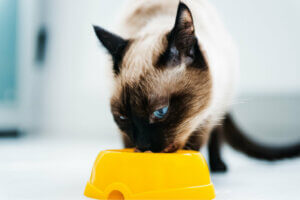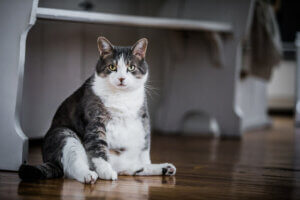Starting a Diet for Cats

Throughout the different stages of a pet’s life, the owner may need to adjust its diet according to specific different nutritional and energy requirements. A kitten, a senior cat, or a pregnant cat don’t have the same needs, and therefore, their diet is mildly different. Understanding this concept helps us keep our pets healthy, at their ideal weight, and free of obesity-associated health problems. Starting a diet for cats may not be easy, but here are a few tips that will help you. Don’t miss out on them.
1. Know your cat’s ideal weight
The ideal weight of a cat depends on several factors: size, age, breed, and sex, among others. The vet can give the owner an idea of the weight that the feline should reach and not exceed.
To know if the animal has an adequate weight, you can observe its body condition. Consequently, you need to pay special attention to the contour and proportion of its body:
- Look at the cat’s silhouette. Is it too round? Is there a clear contrast between the paws and the torso?
- If you can feel the ribs it’s likely that the cat is at its normal weight, and if they’re very pronounced, then the animal may be underweight. On the contrary, if you can neither see the ribs nor touch them easily, the cat is most likely overweight.
- A cat at its ideal weight has an evident waist, with little abdominal fat. When the waist is barely visible and the abdominal fold is absent, due to the large deposits of fat on the abdomen, then the cat is obese.

2. Control food intake
Knowing the ideal weight of each cat is very important. You’ll then know how much food you can give to the pet. On the back of each bag of feed you can find a table that indicates the daily intake corresponding to the weight of the animal.
Also, you should choose the correct intake based on the ideal weight of the pet. Don’t feed for the current weight if the cat is overweight! In that way, the cat will never be able to lose those extra pounds.
Ask your vet what your cat’s weight should be, and feed it according to this ideal weight.
3. Food quality and quantity
The composition of the feed is almost as important as the amount you give it. Felines are strict carnivores, so they need more protein than dogs and don’t require carbohydrates. In fact, these animals have very few enzymes responsible for the degradation of carbohydrates.
A cat’s metabolism is adapted to these characteristics, as it obtains glucose mainly from amino acids. For this reason, cats require a high protein intake.
Make sure that the main nutrients in your cat’s food are proteins of animal origin. Hence, an adult cat should have 30-45% of animal protein in its intake. You can check this by looking at the composition of the feed, as meat should appear first on the list.
You can also opt for a BARF diet. Even so, to make the transition from feed to BARF, you’ll have to read up, and follow the steps indicated by a professional. It’s not an easy process and you’ll have to dedicate time and effort so that you don’t abruptly alter your cat’s health.
4. Feeding guidelines for a cat’s diet
The feeding method may also be an important factor when starting a diet for cats. Here are some tips:
- Offer the food in several takes per day instead of just one.
- Choose methods that slow down the intake. For example, use toys to hide the food or give your cat larger kibbles.
- Don’t give your pet leftovers.
- Weigh the food on a food scale before giving it to the cat.
5. Does a cat diet work? At what rate should it lose weight?
By reducing daily intake, looking for quality food and encouraging the animal to exercise, the owner will be able to see how it loses weight progressively.
Many cat food brands have specialized lines for obese cats, where the proportion of fat and energy in the food is lower. Also, supplements such as L-carnitine are added to help the animal lose weight.
In addition, these feeds have a higher amount of fiber in the diet — up to 15% more — in order to increase the volume of food, and thus give the cat a feeling of satiety quicker.
If the diet works, the animal should experiment a 5% monthly weight loss. The rate is usually slow but continuous.
6. Encourage your cat to move
To make a cat’s diet more effective, encourage your pet to move around, and spend some time playing with it. For example, you can awaken its hunting instinct with different toys, or enrich its environment with a scratching post with several different heights.
To introduce a regular session of playing, it’s best to start with short periods of two to three minutes and increase the duration, as well as the intensity, of the exercises as the cat loses weight.

These are the basic steps for starting a diet for cats, but it’s important to be consistent and monitor the animal’s weight to make sure it’s working. Obese cats are prone to many different diseases and you’ll want to do your utmost to prevent them.
Throughout the different stages of a pet’s life, the owner may need to adjust its diet according to specific different nutritional and energy requirements. A kitten, a senior cat, or a pregnant cat don’t have the same needs, and therefore, their diet is mildly different. Understanding this concept helps us keep our pets healthy, at their ideal weight, and free of obesity-associated health problems. Starting a diet for cats may not be easy, but here are a few tips that will help you. Don’t miss out on them.
1. Know your cat’s ideal weight
The ideal weight of a cat depends on several factors: size, age, breed, and sex, among others. The vet can give the owner an idea of the weight that the feline should reach and not exceed.
To know if the animal has an adequate weight, you can observe its body condition. Consequently, you need to pay special attention to the contour and proportion of its body:
- Look at the cat’s silhouette. Is it too round? Is there a clear contrast between the paws and the torso?
- If you can feel the ribs it’s likely that the cat is at its normal weight, and if they’re very pronounced, then the animal may be underweight. On the contrary, if you can neither see the ribs nor touch them easily, the cat is most likely overweight.
- A cat at its ideal weight has an evident waist, with little abdominal fat. When the waist is barely visible and the abdominal fold is absent, due to the large deposits of fat on the abdomen, then the cat is obese.

2. Control food intake
Knowing the ideal weight of each cat is very important. You’ll then know how much food you can give to the pet. On the back of each bag of feed you can find a table that indicates the daily intake corresponding to the weight of the animal.
Also, you should choose the correct intake based on the ideal weight of the pet. Don’t feed for the current weight if the cat is overweight! In that way, the cat will never be able to lose those extra pounds.
Ask your vet what your cat’s weight should be, and feed it according to this ideal weight.
3. Food quality and quantity
The composition of the feed is almost as important as the amount you give it. Felines are strict carnivores, so they need more protein than dogs and don’t require carbohydrates. In fact, these animals have very few enzymes responsible for the degradation of carbohydrates.
A cat’s metabolism is adapted to these characteristics, as it obtains glucose mainly from amino acids. For this reason, cats require a high protein intake.
Make sure that the main nutrients in your cat’s food are proteins of animal origin. Hence, an adult cat should have 30-45% of animal protein in its intake. You can check this by looking at the composition of the feed, as meat should appear first on the list.
You can also opt for a BARF diet. Even so, to make the transition from feed to BARF, you’ll have to read up, and follow the steps indicated by a professional. It’s not an easy process and you’ll have to dedicate time and effort so that you don’t abruptly alter your cat’s health.
4. Feeding guidelines for a cat’s diet
The feeding method may also be an important factor when starting a diet for cats. Here are some tips:
- Offer the food in several takes per day instead of just one.
- Choose methods that slow down the intake. For example, use toys to hide the food or give your cat larger kibbles.
- Don’t give your pet leftovers.
- Weigh the food on a food scale before giving it to the cat.
5. Does a cat diet work? At what rate should it lose weight?
By reducing daily intake, looking for quality food and encouraging the animal to exercise, the owner will be able to see how it loses weight progressively.
Many cat food brands have specialized lines for obese cats, where the proportion of fat and energy in the food is lower. Also, supplements such as L-carnitine are added to help the animal lose weight.
In addition, these feeds have a higher amount of fiber in the diet — up to 15% more — in order to increase the volume of food, and thus give the cat a feeling of satiety quicker.
If the diet works, the animal should experiment a 5% monthly weight loss. The rate is usually slow but continuous.
6. Encourage your cat to move
To make a cat’s diet more effective, encourage your pet to move around, and spend some time playing with it. For example, you can awaken its hunting instinct with different toys, or enrich its environment with a scratching post with several different heights.
To introduce a regular session of playing, it’s best to start with short periods of two to three minutes and increase the duration, as well as the intensity, of the exercises as the cat loses weight.

These are the basic steps for starting a diet for cats, but it’s important to be consistent and monitor the animal’s weight to make sure it’s working. Obese cats are prone to many different diseases and you’ll want to do your utmost to prevent them.
All cited sources were thoroughly reviewed by our team to ensure their quality, reliability, currency, and validity. The bibliography of this article was considered reliable and of academic or scientific accuracy.
- Pascale Pibot Vincent Biourge Denise Elliot. Enciclopedia de la nutrición clínica felina.
- McDdonald, Edwards, Grenhalgh y Morgan. Nutrición animal. Zaragoza, Editorial Acribia, 1995.
- Purina. Dieta equilibrada para tu gato.
This text is provided for informational purposes only and does not replace consultation with a professional. If in doubt, consult your specialist.








